Private aviation in Britain – the Aero Club of Great Britain
| < Military Aviation in Britain | Δ Index | Secret experiments at Blair Atholl > |
Frank Hedges Butler, was a wine merchant and enthusiastic aeronaut. Whilst flying a balloon over London on 24th September, 1901, with his daughter Vera and the Hon. CS Rolls (of Rolls Royce motors), he decided to form the Aero Club of Great Britain.
 The balloon flight that gave birth to the Aero Club of Great Britain on the 24th September 1901. Seated is Frank Hedges Butler with his daughter, Vera, centre and Charles Rolls top right.
The balloon flight that gave birth to the Aero Club of Great Britain on the 24th September 1901. Seated is Frank Hedges Butler with his daughter, Vera, centre and Charles Rolls top right.
The Club was formed to look after the sport of ballooning and to encourage the development of aviation. Among the founder members were CS Rolls, Griffith Brewer, a balloonist and assistant to Hiram Maxim, Lt Col James Capper of the Army School of Ballooning, and Col Templer who ran the Army’s Balloon Factory.
By 1907 the balloonatics of the Aero Club were exasperated by the lack of Government interest in aeroplanes. Claude Moore-Brabazon had been to France and came back full of enthusiasm and he asked the Aero Club’s official aeronautical engineers, two brothers by the name of Short to build him a glider. In parallel, CS Rolls was pleading with the Wrights to let him be their UK Rep.
The Short Brothers
The two brothers, Eustace and Oswald Short were enthusiastic balloonists who had started making ascents in 1897. A third brother, Horace, had decided, after one trip, that he was not into balloons and had gone his own separate way.
Oswald and Eustace started a small balloon-making shop off Tottenham Court Road but moved to a railway arch near the gas works (an essential move for serious users of coal gas) in a Battersea Railway Arch in 1906. They made balloons for C S (Charlie) Rolls, Frank McClean, Claude Moore-Brabazon and Griffith Brewer, all Aero Club members. The glider order from Moore-Brabazon was Shorts’ first adventure into heavier-than-air. They charged £25 and even fitted it with a French Buchet engine.
Wright Brothers in the UK
By the end of May 1908 Wilber had arrived in France, unpacked his crated 1907 flyer and prepared to give public displays. He was confident that his flyer possessed the manoeuvrability, control, power, and propeller efficiency to outperform anything they were aware of in Europe. In the States Orville began a series of public in displays. On August 8th 1908 Wilber flew at Le Mans in front of 2000 people. They were astounded. The newspapers declared that a new era was dawning.
Just before Cody’s first flight on October 16th 1908 day Wilber Wright had suggested to Rolls that he could have a Wright Flyer by having it built in England. The Wrights said that they were prepared to grant a licence to a British Firm to build the Flyer under licence. CS Rolls replied that he thought this was feasible and said that two of the best people were “coming over to see you”.
The best people were, of course the Short Brothers. Eustace and Oswald Short contacted their brother Horace where he was working on steam turbines and related the plan to go to the Wrights and to build practical heavier-than-air machines. Horace was so enthusiastic that he gave his brothers just three days to get organised. Otherwise he would go it alone. The new partnership was registered as a company with £200 from each brother.
The club established its first flying ground on a stretch of marshland at Shellbeach near Leysdown on the Isle of Sheppey in early 1909. Among the first occupants of the ground were the Short Brothers.
First British Flight by a British Pilot
On 1 May 1909 John Moore-Brabazon (later Lord Brabazon) made a flight of 500 yards in his Voisin at Shellbeach. This is officially recognised as the first flight by a British pilot in Britain.
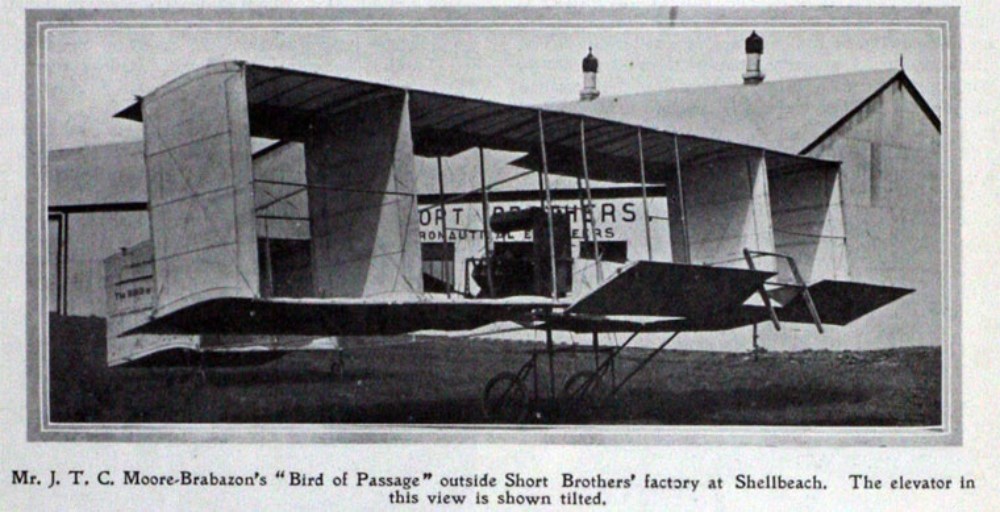 Brabazon’s Voisin “Bird of Passage” outside the Short Brothers factory at Shellbeach
Brabazon’s Voisin “Bird of Passage” outside the Short Brothers factory at Shellbeach
The same week (May 1909) the Wright brothers visited the Aero Club flying ground. After inspecting the Short Brothers’ factory, a photograph was taken outside Mussell Manor of the Wright Brothers with all of the early British aviation pioneers to commemorate their visit to Britain.
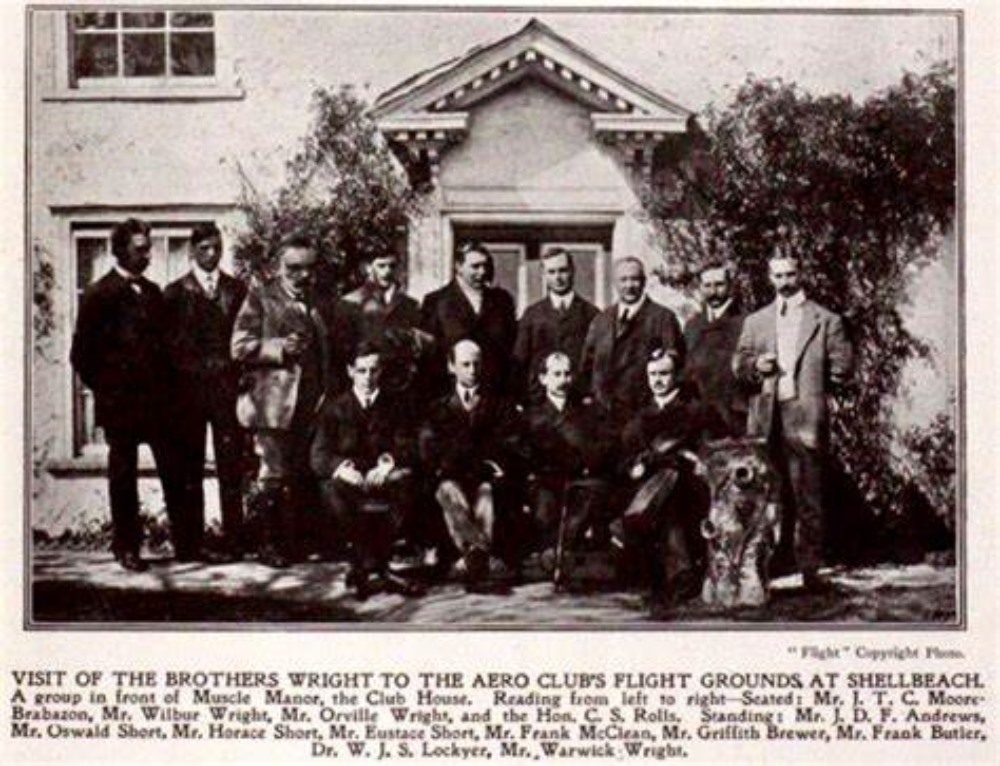 Standing left to right are: Mr T D F Andrews, Oswald, Horace & Eustace Short, Frank McClean, Griffith Brewer, Frank Hedges Butler, Dr W J S Lockyer and Warwick Wright.
Standing left to right are: Mr T D F Andrews, Oswald, Horace & Eustace Short, Frank McClean, Griffith Brewer, Frank Hedges Butler, Dr W J S Lockyer and Warwick Wright.
Seated left to right are: J T C Moore- Brabazon, Wilbur & Orville Wright and the Hon CS Rolls.
On 30 October 1909, Moore-Brabazon was the first to cover a mile (closed circuit) in a British aeroplane, flying the Short-Wright Biplane No. 2, and so winning a prize of £1,000 offered by the Daily Mail newspaper.
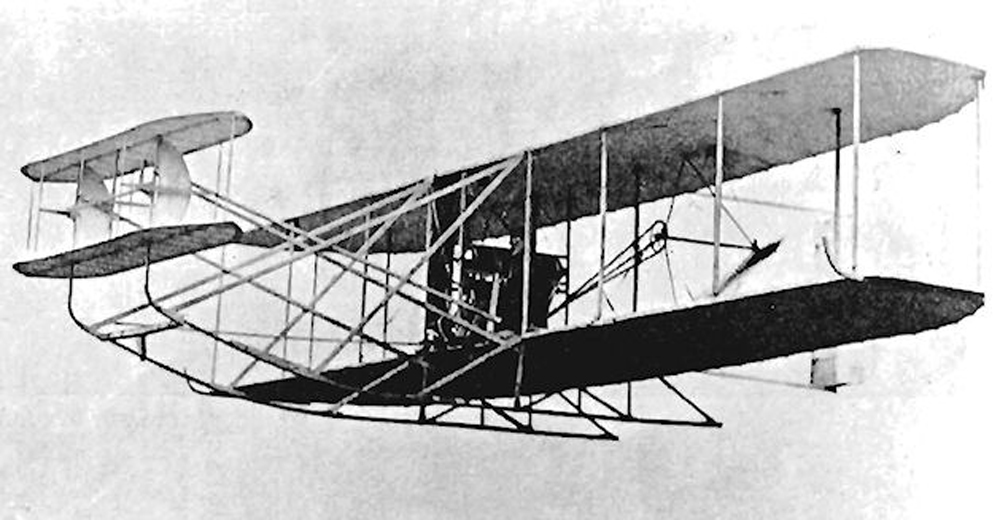 The Short-Wright biplane
The Short-Wright biplane
On 4 November 1909, he took up a piglet as a passenger, disproving the adage that “pigs can’t fly”.
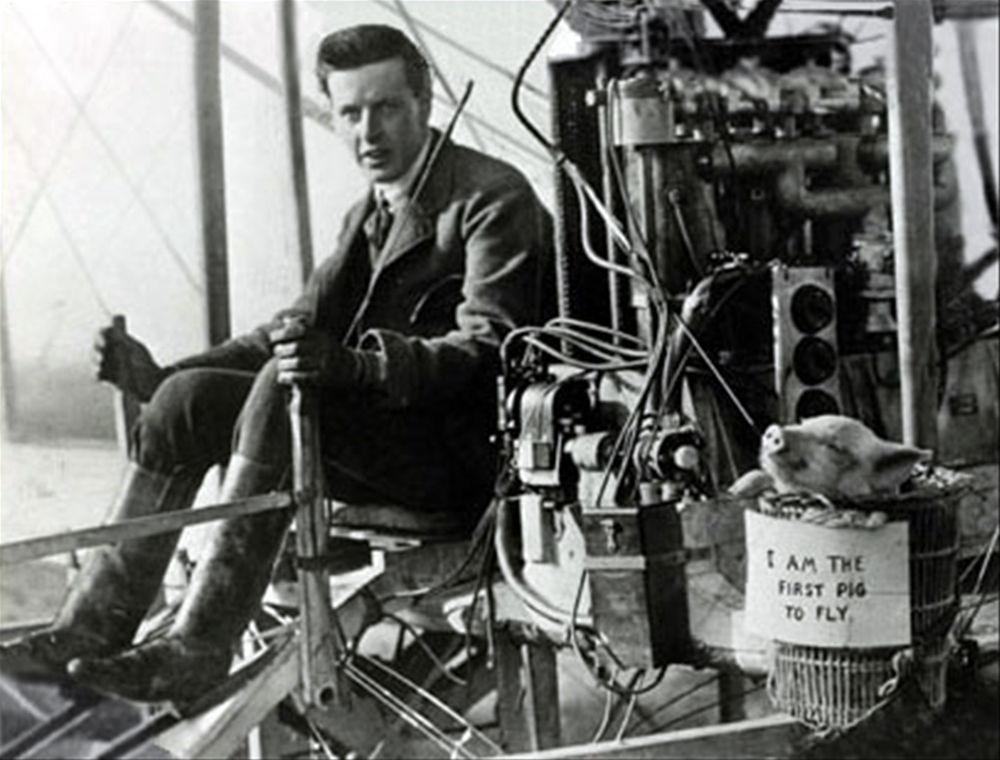
By the end of 1909 the Aero Club decided to move to Eastchurch. Frank McClean announced that any Aero Club member could erect a shed there and have use of the airfield for a rent of one shilling per year.
[The Eastchurch Aviation Museum occupies part if this site. It is well worth a visit.]
McClean sold three acres of Eastchurch to Shorts for £25 for their factory and told them to start producing aircraft. He also offered to buy any that they could not sell. Shorts would not have survived but for his backing.
Shorts built no more Wright Flyers but ventured into building their own developments and to the plans of others. They built an aircraft for the Blair Atholl Syndicate to Capt Dunne’s specification and for Professor Huntington. Both were inherently stable designs.
In January Leo Jezzi (a “city gent” with a strong bent for mechanics) arrived at Eastchurch with the makings of an aircraft, calico under one arm, packing case under the other and a motorcycle engine on his back. His friends told him he was quite mad and would break his neck, but he succeeded and flew his own aircraft in August.
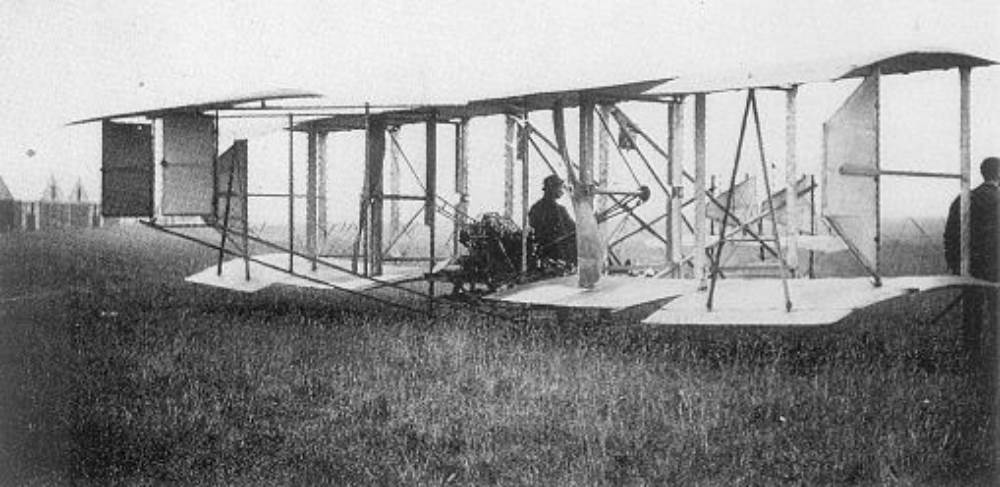 The Jezzi biplane
The Jezzi biplane
First Pilots’ Certificates
In March 1910 Moore-Brabazon was awarded the first Aero Club Pilots’ certificate although he had learned to fly in France two years earlier. CS Rolls got certificate No2. The Olympia Motor Show took place this month and King Edward VII gave the Aero Club permission to use the prefix “Royal”.
In June 1910 a new Short biplane was produced. In this machine Shorts abandoned the Wright design and produced an aircraft similar to Farman pusher types.
Also in June CS Rolls, flying his Short Wright biplane, made the double-crossing of the Channel without stopping.
Regrettably, on 12th July, whilst competing at Bournemouth in a spot landing competition he suffered a structural failure trying to recover from a steep dive and was killed.
J. W. Dunne had been working on the design of an intrinsically stable aeroplane in great secrecy at Blair Atholl from 1904. He flew his latest model at Eastchurch in 1910.
| < Military Aviation in Britain | Δ Index | Secret experiments at Blair Atholl > |